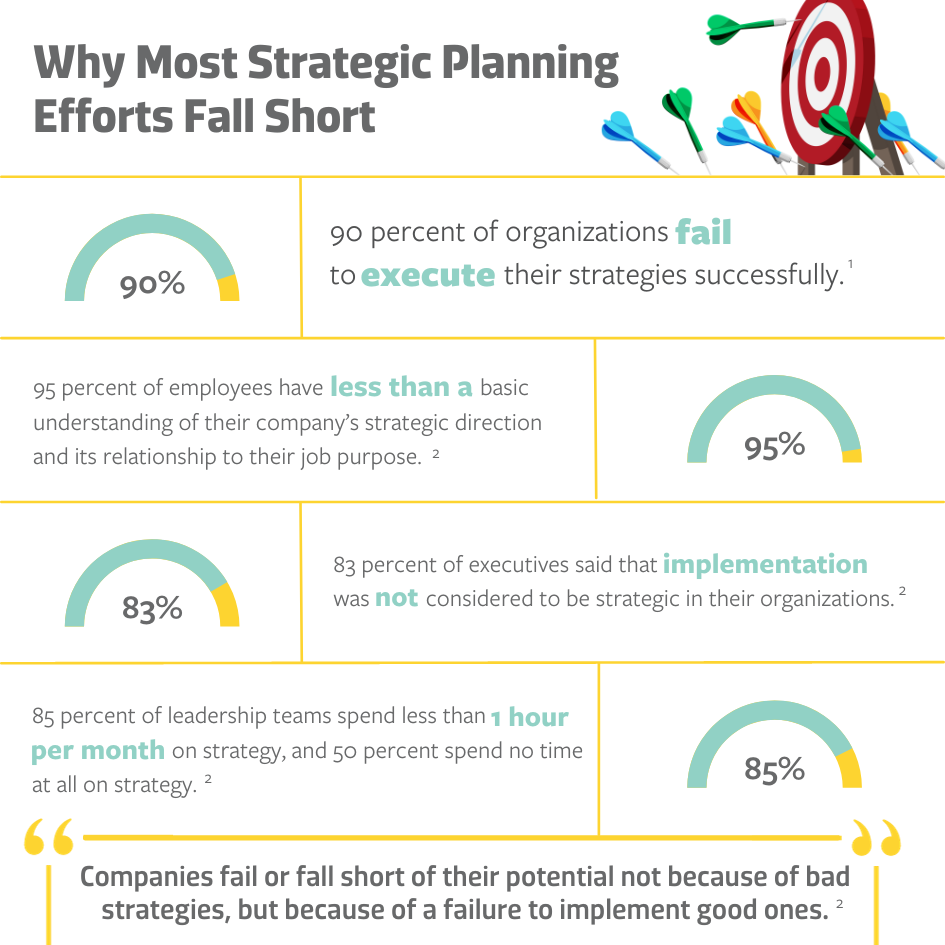
Most strategies fail. Here's how to beat the odds and drive results faster.
Go beyond your typical strategic planning process and consider implementing a transformative approach that drives elite performance as a standard for your organization.
In today’s era of rapid change and innovation, stakeholders within your organization are eager for opportunities to shape the direction of your company and contribute insights to the broader strategy. Many CEOs and executives want to adapt how strategy is designed within their organizations and strive to prioritize long-range strategy in addition to driving real-time business results.
The paradigm shift required to achieve the flexibility demanded in today’s market while maximizing financial outcomes is ambitious but also achievable. It involves modernizing your business practices, re-orienting your strategy as the organization’s heartbeat, and creating a culture that connects to exceptional performance. The secret to success lies in the simultaneous development of both the organizational strategy and the leadership acumen of those who bring your strategy to life.
Statistics show that only 10% of organizational strategies are realized as initially designed. The four most common failure points are:
- Underdeveloped execution systems
- Scaling talent ahead of the business
- Poor executive team alignment and effectiveness
- Limited stakeholder engagement


1. The Balanced Scorecard, by David Norton and Robert Kaplan
2. Project Management Institute. “Why Good Strategies Fail: Lessons for the C-suite.” The Economist. 2013
Successful strategy implementation can happen when your organization’s collective mindset is focused on the health of the enterprise and when you choose to blend strategy, leadership development, and organizational transformation into one agile, adaptable process.
This type of forward-thinking will deliver sustainable value at every level, regardless of your market sector.
Here are five key steps to implementing this proven, blended approach and why each one matters to you as an executive, your colleagues, and your customers.
Step One: Strategic Readiness Assessment
The best strategies begin with clear insights into the enterprise trends. By assessing your organization’s strategic readiness, you gain collective insights into your team performance, enterprise dynamics, and change management agility. These insights ensure your strategy is connected to and informed by the strengths and weaknesses of the organization.
Why it matters to CEO/Executives:
- Highlights Strategic Focus: This comprehensive analysis leads you to a more focused and relevant strategic plan that prioritizes the most significant areas for growth — strengths to build on what the organization does well and acknowledgment of challenges to provide a basis for addressing critical issues.
- Ensures Appropriate Resource Allocation: With a clear understanding of existing strengths and challenges, you can allocate resources — financial, human, and time — more efficiently to ensure that resourcing decisions made during strategic planning are realistic, intentional, and of the highest impact.
Why it matters to Colleagues:
- Encourages Aligned and Informed Decisions: Informed colleagues are better equipped to make effective decisions and can allocate resources, prioritize initiatives, and respond to challenges in a way that is aligned to maximize success.
- Provides Understanding of Capability and Capacity Gaps: Assessing strategic readiness ensures that current capability and capacity gaps are incorporated into the strategic plan and appropriately addresses talent, training, and resourcing needs to enable successful execution at all levels.
Why it matters to Customers:
- Offers Customer-Centric Strategy: A thorough understanding of your organization’s strengths and challenges enables the development of a customer-centric strategy, resulting in products, services, and experiences that better align with customer expectations.
- Invites Continuous Innovation: Leveraging your strengths to introduce new products or services while addressing known challenges will foster a culture of continuous improvement and customer-focused innovation.
To learn more about the critical areas to assess before developing your strategic plan, read our article, Assessing Your Organization’s Strategic Readiness
Step Two: Strategic Planning and Prework Process
Dedicating resources for an inclusive and engaging planning and prework process ahead of your planning sessions will ensure that your transformation is anchored in insights provided by the collective. This process promotes individual strategic thinking and can equalize engagement and influence going into the session.
Why it matters to CEO/Executives:
- Increases Buy-In from Larger Team: While robust prework requires added effort on the front end, engaging the broader team in the pre-planning process pays significant dividends because once the strategy is set, you won’t have to convince your leaders to buy into the transformation because their insights helped inform, shape, and fuel it.
- Drives an Aligned Team: A robust planning and prework process facilitates alignment among the executive team, sets the tone for enterprise-level strategic thinking, and allows the team to “hit the ground running” in the strategy session.
Why it matters to Colleagues:
- Increases Ownership: When next-level leaders are engaged in the planning process, they are more likely to take ownership of the strategy and champion its execution within their teams.
- Expands Strategic Acumen: Including additional leaders in the prework process levels up their strategic thinking and empowers them to think enterprise-first versus department or self-first.
Why it matters to Customers:
- Provides Holistic Understanding: Assessing the external environment your customers are operating in helps to identify areas where you may be falling short of their expectations, leading to an improved brand experience strategy.
Encourages Diverse Perspectives: Engaging the lower-level leaders who typically work more closely with your end user ensures that the voice of your customer is represented. This broader team can provide customer perspectives ahead of the strategic planning process.
Step Three: Strategic Planning Session
Committing the time and resources to develop a long-range transformational strategy with your key senior leaders is a powerful method to crystalize your mission while simultaneously igniting the mindset, approach, and collaboration needed for the next evolution of business. When you create targeted goals and deliverables with clear accountability, you enable an enterprise-first leadership team to execute with focused engagement.
Why it matters to CEO/Executives:
- Produces Common Purpose & Strengthens Connection: With a transformational strategic plan in hand, your executive team is more synergistic in championing the common enterprise goals and gaining clarity, trust, and confidence around the overall performance of the enterprise.
- Elevates Executive Acumen: Providing the time and space for collective strategic planning enables your entire executive team to step fully and confidently into owning the enterprise vision.
Why it matters to Colleagues:
- Clarifies Expectations and Roles: With both an inspirational long-term strategy and a detailed near-term strategy, colleagues can directly tie their actions to the greater impact of their work and how they can contribute to the organization’s success.
- Fosters Cascading Development: With a clear strategy in place, leaders across your organization can embed strategic conversations in team discussions, helping create a systemic and sustainable approach to accelerate strategic thinking across all levels of the organization.
Why it matters to Customers:
- Builds Consistency and Reliability: A solid strategic plan includes elements that ensure consistency and reliability in the delivery of products and services. This consistency builds confidence among your customers as they come to rely on your organization for a dependable experience.
- Establishes Competitive Advantage: By clearly identifying your unique value proposition and strategizing around your market position, you’ll stand out in a crowded marketplace with offerings that clearly benefit your target audience.
Step Four: Strategy Rollout and Action Planning
Thoughtfully communicating your strategy and creating a detailed action plan provides your organization with a clear roadmap and accountability cadence that is fueled by an aligned team. This process also promotes the adoption and ownership of the strategy by your next-level leaders as it accelerates the strategic buy-in through their expanded engagement.
Why it matters to CEO/Executives:
- Creates Collective Bandwidth: Engaging leaders across all levels creates bandwidth to drive execution through your organizational leadership and provides a pathway for inclusivity and empowerment.
- Clarifies Talent Planning: Executives gain clarity on their own talent planning needs and team capabilities, which allows them to focus on where the business is heading instead of being mired in the day-to-day. This can also provide needed insight into high-potentials and talent gaps that may exist for effective strategic plan execution.
Why it matters to Colleagues:
- Invites Diversified Perspectives: Involving a larger group of leaders in the action-planning process ensures that perspectives across functions and levels of the organization are incorporated. These varied viewpoints lead to an innovative plan grounded in a comprehensive understanding of the business.
- Elevates Strategic Acumen: Including your next level leaders in this process is a valuable investment in their development. It equips them with expertise, insights, and skills that enhance their strategic acumen and prepares them to contribute to the organization’s long-term success.
Why it matters to Customers:
- Enhances Problem-Solving: When facing customer-related challenges, a variety of perspectives can offer different angles for addressing issues, lead to more effective problem-solving, and allow for solutions that cater to a broader range of customer needs.
- Integrates Customer Feedback: Front-line leaders have connections and experiences that facilitate the collection and integration of customer feedback to help ensure that customer opinions and preferences are considered in the annual goal-planning process.
Step Five: Continuous Execution and Alignment Sessions
Since markets, industry, and customer needs are dynamic and disruption is a continuous factor in today’s competitive landscape, your organization’s timely response is critical. A committed cadence of execution reviews and alignment sessions is often the missing piece for successful strategy implementation. It’s important to ensure the achievement of your strategy while continuing to elevate your team’s engagement by honoring a commitment to continuous alignment sessions.
Why it matters to CEO/Executives:
- Enhances Execution: Dedicating time to assess and elevate the execution dynamics that exist across your enterprise and within execution teams drives execution efficiency and addresses needed pivots in real-time.
- Deepens Relationships: CEOs and executives learn to create a healthy culture of challenge, managing feedback and transparency that deepens the relationships and commitments of team members.
Why it matters to Colleagues:
- Fosters a Learning Culture: Through this process, next-level leaders gain new levels of partnership and mentorship from the executive team and are encouraged in a culture of continued learning and improvement.
- Promotes Accountability: Regular execution review sessions establish a framework for tracking progress and holding execution teams accountable.
Why it matters to Customers:
- Enhances Feedback Integration: Regular strategy review allows your organization to integrate customer feedback in a timely manner and make necessary adjustments to address issues and trends while striving to improve the customer experience.
- Instills Trust and Loyalty: Trust is fostered when your organization commits to ongoing improvement and alignment with customer needs. Those customers are more likely to remain loyal as you continually strive to enhance their experience.
Leveraging your strategy enables you to transform your workforce into a collective genius behind a thriving culture centered on achieving enterprise goals regardless of disruption and challenge. Our clients have achieved undeniable results in less time by deploying these techniques within large global Fortune 500 companies, portfolio companies of private equity firms, and well-funded startups.
If you have questions or would like help with our best-in-class strategic process, please reach out to Meghan McClimon or a Transcend team member today.


